Grief Counseling in High School
- 1. Grief Counseling in the High School Setting Deanna Ainsworth University of West Alabama SC540
- 2. Basic counselor roles are outlines. Sample Crisis plan is discussed. Tips are given to help staff address grief with their students. Sample group therapy is outlined. Ethical and legal considerations are outlined.
- 3. Adolescents in high school may experience grief in many different ways. They may experience the loss of a parent, sibling, family member, friend, acquaintance, or teacher. By the time a child exits school, 40% will experience the loss of a peer and 20% will have witnessed a death ("Guidelines for responding to the death of a student or school staff," n.d.).
- 4. Often counselors are the oneŌĆÖs reporting the loss to administration and in turn activate the schoolŌĆÖs crisis plan when dealing with a traumatic loss. Counselors are also notified of a death in the family. The counselor would want to plan an initial meeting with the student and possibly consider group therapy.
- 5. Activate the schoolŌĆÖs crisis team and coordinate with administrators, other schools that may be impacted, and any outside counseling resources. 1. Verify the information. 2. Determine what information should be released with respect to the familyŌĆÖs wishes. 3. Formulate a plan on informing staff and students.
- 6. This can be done by administrators, school guidance counselors, or district office representatives. A staff meeting should be held before school to address what information is known, answer any questions from staff, and formulate a plan on how to address the students.
- 7. Many students may already know or have heard rumors of what has happened. Notification should be done face-to-face with a familiar teacher, counselor, or staff member ("Guidelines for responding to the death of a student or school staff," n.d.). Often it is advisable for a guidance counselor or administrator to draft a sample statement for teachers to read to their students. Some teachers may feel uncomfortable discussing the incident with their students. In the staff meeting, it should be clearly outlined what should and should not be discussed with the students.
- 8. Saying nothing tells students their teacher is: uncaring, insensitive, unapproving, and unconfident. Teachers should: Express concern Be genuine Invite conversation Listen and observe Limit personal sharing Offer reassurance (ŌĆ£Talking with children,ŌĆØ n.d.)
- 9. Identify students in need. Meet individually with students to outline group rules and establish consent from parents/guardians. Organize meeting place and times. 8 week program is suggested. ("Grief support groups in the school setting: A guide for school counselors," n.d.)
- 10. 1. Telling the story. 2. Signs and symptoms of grief. 3. Physical symptoms of grief and the grief cycle. 4. The value of memories. 5. Exploring changes and regret. 6. Finding comfort in grief. 7. Personal growth. 8. Continuing bonds. ("Grief support groups in the school setting: A guide for school counselors," n.d.)
- 11. There are certain circumstances in which parents may not want the cause of death disclosed. ParentŌĆÖs wishes must be honored, however, the death itself must be addressed. Counselors should also be aware that the release of details may cause more harm to students.
- 12. Decline in school performance. Difficultly mastering new material. May become more irritable, withdrawn, depressed, or anxious. Partake in risky activities and behaviors. Stay focused on loss. ("Guidelines for responding to the death of a student or school staff," n.d.)
- 13. Lake Havasu High SchoolŌĆÖs Mission Statement: "...we are dedicated to challenging our students, to delivering a rigorous curriculum, to developing responsible citizens, and to forming positive relationships.ŌĆØ Improperly counseled students cannot become productive and responsible citizens who are capable of forming positive relationships. Grief is capable of consuming all aspects of a students life; whether it is at home, at school, or amongst relationships.
- 14. Grief support groups in the school setting: A guide for school counselors. (n.d.). Retrieved from https://www.google.com/url?sa=t&rct=j&q=&esrc=/slideshow/video-presentation-grief-counseling/44659567/s&source=web&cd=1&cad=rja&uact=8&ved=0CB4QFjAA&url=https%3A%2F%2Fwww.seattleu.edu%2Fup loadedFiles%2FCOE%2FPrograms%2FCounseling%2FCurrent_Students%2FEvents_Documents%2FGrief%2520Resource.pdf&ei=4U3WVLKdH8zagwTX1ID ACA&usg=AFQjCNHhmHi-RvX5N79wBxtXzNQXCXTtbw&sig2=2hWf0LCrFxkov4ZOfr8mKA&bvm=bv.85464276,d.eXY Guidelines for responding to the death of a student or school staff. (n.d.). Retrieved from http://www.google.com/url?sa=t&rct=j&q=&esrc=s&source=web&cd=2&cad=rja&uact=8&ved=0CCQQFjAB&url=http%3A%2F%2Fwww.cincinnatichildrens. org%2FWorkArea%2FDownloadAsset.aspx%3Fid%3D77092&ei=OkjWVJ7FKIegNrW1gbgN&usg=AFQjCNEkD_V2yntFw9so6jmtCd30DInmpg&sig2=iY0Ni uY4aYPwFdPmBxQPZQ Helping children cope with death. (n.d.). Retrieved February 7, 2015, from http://www.madd.org/victim-services/finding-support/victim-resources/helping-children-cope- with.pdf [Photograph of chairs]. Retrieved from http://www.google.com/url?sa=i&rct=j&q=&esrc=s&source=images&cd=&cad=rja&uact=8&ved=0CAcQjRw&url=http%3A%2F%2Fwww.minddisorders.com %2FFlu-Inv%2FGroup- therapy.html&ei=jU_WVLjCAYayggS1wYGgDg&bvm=bv.85464276,d.eXY&psig=AFQjCNH8MDuM5MUE50u5vWRVlAyaNz94sg&ust=142341761084469 1 [Photograph of hands covering face]. Retrieved from http://www.google.com/url?sa=i&rct=j&q=&esrc=s&source=images&cd=&cad=rja&uact=8&ved=0CAcQjRw&url=http%3A%2F%2Fannarborcounselingservice s.com%2Fservices%2Fgrief-counseling%2F&ei=uE_WVIDHDNOTNrvNglg&bvm=bv.85464276,d.eXY&psig=AFQjCNGU1- 5aJo_ejdKUDt3bZBp_pG4H7g&ust=1423417652391938 Talking with children. (n.d.). Retrieved February 7, 2015, from http://grievingstudents.scholastic.com/wp-content/uploads/2014/12/NYL-1A-Talking-With-Children.pdf Teachers dealing with trauma and grief [Video file]. (n.d.). Retrieved from https://www.youtube.com/watch?v=PnOvH1Qv8L0













![Grief support groups in the school setting: A guide for school counselors. (n.d.). Retrieved from
https://www.google.com/url?sa=t&rct=j&q=&esrc=/slideshow/video-presentation-grief-counseling/44659567/s&source=web&cd=1&cad=rja&uact=8&ved=0CB4QFjAA&url=https%3A%2F%2Fwww.seattleu.edu%2Fup
loadedFiles%2FCOE%2FPrograms%2FCounseling%2FCurrent_Students%2FEvents_Documents%2FGrief%2520Resource.pdf&ei=4U3WVLKdH8zagwTX1ID
ACA&usg=AFQjCNHhmHi-RvX5N79wBxtXzNQXCXTtbw&sig2=2hWf0LCrFxkov4ZOfr8mKA&bvm=bv.85464276,d.eXY
Guidelines for responding to the death of a student or school staff. (n.d.). Retrieved from
http://www.google.com/url?sa=t&rct=j&q=&esrc=s&source=web&cd=2&cad=rja&uact=8&ved=0CCQQFjAB&url=http%3A%2F%2Fwww.cincinnatichildrens.
org%2FWorkArea%2FDownloadAsset.aspx%3Fid%3D77092&ei=OkjWVJ7FKIegNrW1gbgN&usg=AFQjCNEkD_V2yntFw9so6jmtCd30DInmpg&sig2=iY0Ni
uY4aYPwFdPmBxQPZQ
Helping children cope with death. (n.d.). Retrieved February 7, 2015, from http://www.madd.org/victim-services/finding-support/victim-resources/helping-children-cope-
with.pdf
[Photograph of chairs]. Retrieved from
http://www.google.com/url?sa=i&rct=j&q=&esrc=s&source=images&cd=&cad=rja&uact=8&ved=0CAcQjRw&url=http%3A%2F%2Fwww.minddisorders.com
%2FFlu-Inv%2FGroup-
therapy.html&ei=jU_WVLjCAYayggS1wYGgDg&bvm=bv.85464276,d.eXY&psig=AFQjCNH8MDuM5MUE50u5vWRVlAyaNz94sg&ust=142341761084469
1
[Photograph of hands covering face]. Retrieved from
http://www.google.com/url?sa=i&rct=j&q=&esrc=s&source=images&cd=&cad=rja&uact=8&ved=0CAcQjRw&url=http%3A%2F%2Fannarborcounselingservice
s.com%2Fservices%2Fgrief-counseling%2F&ei=uE_WVIDHDNOTNrvNglg&bvm=bv.85464276,d.eXY&psig=AFQjCNGU1-
5aJo_ejdKUDt3bZBp_pG4H7g&ust=1423417652391938
Talking with children. (n.d.). Retrieved February 7, 2015, from http://grievingstudents.scholastic.com/wp-content/uploads/2014/12/NYL-1A-Talking-With-Children.pdf
Teachers dealing with trauma and grief [Video file]. (n.d.). Retrieved from https://www.youtube.com/watch?v=PnOvH1Qv8L0](https://image.slidesharecdn.com/videopresentation-griefcounseling-150213163432-conversion-gate02/85/Grief-Counseling-in-High-School-14-320.jpg)